On the hunt for a dynamic core exercise that will elevate your plank to the next level? Mountain climbers. Searching for one of the best bodyweight cardio exercises to add to your equipment-free conditioning sessions? Mountain climbers.
They may seem simple, but mountain climbers are one of the most multi-functional full-body bodyweight moves around. Keeping yourself in a steady plank position taxes your shoulders and triceps, while the isometric hold and knee movements fire up your core. And, of course, your legs will be pumping the whole time — not to mention your heart rate.
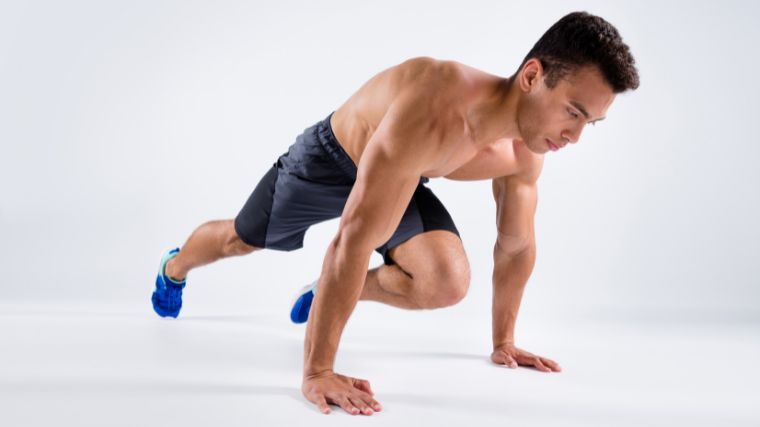
Here, you’ll learn everything you need to know about how to do mountain climbers, as well as why you should.
Table of Contents
- How to Do Mountain Climbers
- Mountain Climber Variations
- Mountain Climber Alternatives
- Mountain Climber Tips
- Benefits of Mountain Climbers
- Muscle Worked by Mountain Climbers
- Who Should Do Mountain Climbers
- Common Mountain Climber Mistakes
- Frequently Asked Questions
Editor’s Note: The content on BarBend is meant to be informative in nature, but it should not be taken as medical advice. When starting a new training regimen and/or diet, it is always a good idea to consult a trusted medical professional. We are not a medical resource. The opinions and articles on this site are not intended for use as diagnosis, prevention, and/or treatment of health problems. They are not substitutes for consulting a qualified medical professional.
How to Do Mountain Climbers
You won’t need any equipment for this powerhouse of a bodyweight exercise. You may want an exercise mat or yoga mat to cushion your hands.
Just be aware that if you opt to move your feet quickly, some mats might shift or bunch up. So, set it up where only your hands (and not your feet) are on it.
Step 1 — Assume a Plank Position

Get into a plank position with your hands underneath your shoulders and your toes pointed. Keep your hips and shoulders in line. Shift your heels back slightly to engage your core, but keep your weight distributed evenly between your toes and hands.
Coach’s Tip: If you need more space between the ground and your body so that your knees will be able to travel more freely, brace your hands on a weight bench or stable chair instead of on the ground. This will put you into an incline plank position. You can proceed from there.
Step 2 — Pull Your Knees

Maintaining a steady plank, pull your left knee underneath your body toward your chest. Avoid shifting your hips and lower back from side to side as much as possible.
Coach’s Tip: Think about pulling your knees toward your chest instead of driving them. This will help keep your core engaged.
Step 3 — Tap and Switch
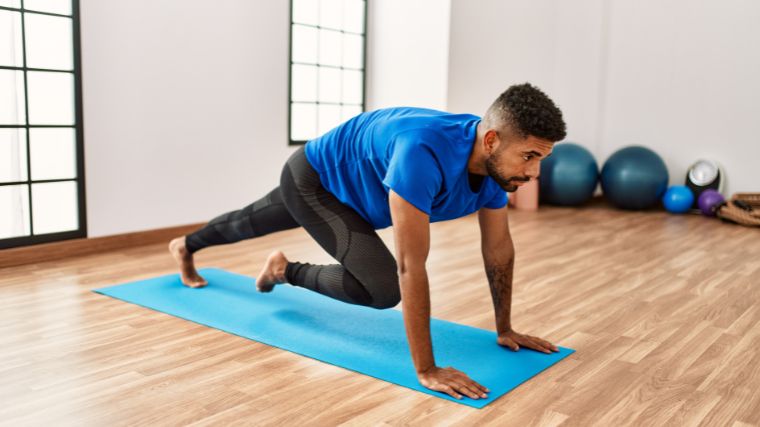
Bring the left knee back until your left toes touch the ground again. Switch legs so that your right knee comes toward your chest this time. Keep switching at a pace that suits your goals. Keep your shoulders engaged with your shoulder blades back and down, away from your ears.
Coach’s Tip: If your main goal is to increase core strength, do this slowly. If your main goal is to boost your heart rate for a more cardio-style workout, gradually perform the switches faster.
Mountain Climber Variations
Got the basics down and ready to spice things up? Here are some different types of mountain climbers to try out in your next session.
Down Dog Mountain Climber
You’ll be borrowing a bit from your yoga class here. Do these when you want to emphasize your upper back, shoulders, and triceps while reaping all the other benefits of mountain climbers, too.
- Get into a down dog position by starting in a plank, then reaching your hips up and back toward the back of the room.
- Press through your hands to distribute weight evenly.
- Bend your left knee so that your foot leaves the ground. Maintain an even distribution of weight between your hands and your right foot. Extend your left leg up and out behind you.
- Bring your left knee down and under your body toward your chest. Hold for a moment, extend it back, and reset your position.
- Repeat with the right leg.
Spider Mountain Climber
Arachnophobia can take a seat — you won’t need to think about any eight-legged frenemies to do this one. You’ll simply be moving your legs out closer to the sides, increasing your stability challenges and oblique stimulation.
- Set up in a plank position, just like for regular mountain climbers.
- Bend your left knee and bring it up along the left side of your body. Without shifting your hips, bring your left knee as close to your left elbow as possible.
- Return to starting position. Repeat on the right side.
Cross-Body Mountain Climber
Some people naturally do mountain climbers with a cross-body emphasis. If need be, elevate your starting position by bracing your hands on a bench or stable chair to give your legs room to move under your body.
- Set up in a plank position as for a typical mountain climber.
- Bend your left knee and bring it under your body. Without shifting your hips or shoulders, bring your left knee as close to your right shoulder as possible.
- Reset your position. Repeat on the right side.
Mountain Climber Alternatives
If you’re still building up to performing mountain climbers, or need a different option altogether, don’t sweat it. There are plenty of other ways to reap the benefits.
High Knee
Essentially, a mountain climber is a high knee performed in a plank position. Eliminate the plank component to make a more accessible standing version that doesn’t involve supporting your upper body.
- Stand tall with your hands by your sides and your feet hip to shoulder-width apart.
- Ground through your right foot for balance. Bend your left knee and bring it up toward your chest. Avoid crunching your chest forward, but tighten your core as you lift so that your abs are being challenged.
- To create more room for your stomach, raise your leg slightly out to the side. Hold an anchor for balance if need be.
- Lower the left leg and switch. Once you establish balance, perform these as quickly as possible. You can hold your hands out at stomach level to meet your thighs with each rep.
Plank
To perform a mountain climber in the traditional way, you’ll need to get a solid grip on the plank. You’ll be holding a plank position for as long as each mountain climber set takes you, so this is an essential skill to build.
- Get on the ground with your hands underneath your shoulders and your legs fully extended behind you, your toes planted on the ground. Keep your feet close together for an added challenge, but put them a little wider than hip-width apart for more balance and support.
- If need be, you can start your plank with your hands on a higher surface so your body is on more on an incline. Just try to avoid your hips sagging to keep your core engaged and your lower back safe.
- Drive your heels back behind you, keep your shoulders away from your ears, and squeeze your quads, glutes, and core.
- Breathe deeply in and out through your stomach. Maintain core tension and hold for as long as possible.
Plank Jack
Once you can do planks, you might switch to plank jacks to add a cardiovascular fitness element. Like mountain climbers, these will get your heart rate up. But, because you won’t be bending your knees and bringing your legs under your body, they won’t be quite as intense.
- Set up in plank position with your feet close together.
- Once you feel steady, hop your feet out wide and to the sides. Land softly on your toes. This should resemble the lower body portion of a standing jumping jack.
- Without letting your hips sag or your shoulders flare, hop your feet back together. Repeat for reps, maintaining tension in your core throughout the exercise.
Mountain Climber Tips
So many exercises are about helping you increase strength or stimulate hypertrophy. That’s not the case with mountain climbers. If you’re new to lifting, almost any movement will help get you stronger and more muscular — but that’s not the mountain climbers’ specialty.
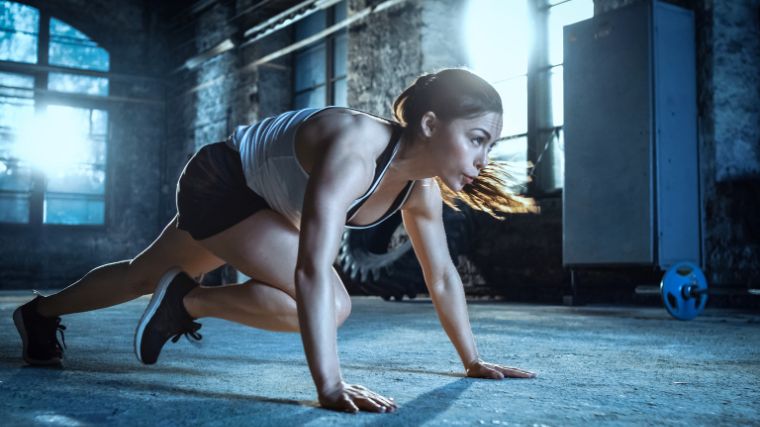
[Read More: The Complete Guide to Pre-Workout Supplements]
Instead, you’ll use this exercise for warming up, as a workout finisher, and building full-body endurance. Here’s how.
- For Warming Up: Perform one set of 10 slow, controlled reps per side. Then, do one set of 10 faster reps per side.
- For a Finisher: Do two to four sets of AMRAP (as many reps as possible) in one minute. Rest for a minute between each set.
- For Endurance: Perform one set to near exhaustion. Count your reps. Rest for one minute, then reach that same number of reps. Repeat once or twice more, always attempting to reach that first number but stopping each set early if your form starts to fail.
Benefits of Mountain Climbers
No, you won’t actually be climbing a mountain. But your body might not know the difference. Here are some pretty compelling reasons to hop into plank position.
Relatively Low Impact
Unlike other popular bodyweight cardio options — like running, box jumps, or squat jumps — mountain climbers don’t require quite as much slamming around on your joints. When you do them quickly, they can err toward a higher impact.
But even so, you’ll never be landing with your full body weight on your feet since your upper body will remain supported by your hands. Plus, the idea is to stay light on your toes instead of letting them slam down between each step.
Increase Heart Rate
Mountain climbers are going to make your heart rate… well, climb. When you want a way to get in a cardio-focused workout without leaving your living room, mountain climbers are a fantastic option.
[Read More: The Best Online Workout Programs for Coaching, Cardio, Value, and More]
The fast-paced nature of this movement is going to work your cardio endurance for sure. Just put a towel down and have a water bottle close by — you’re bound to get sweaty.
Full Body Strength and Endurance
Your entire body will work together to complete even a single rep of mountain climbers. The combined effort of holding your upper body in place, maintaining core integrity, and essentially performing intense high knees is a literal head-to-toe effort.
You’ll be holding a dynamic plank position for however long it takes you to complete your reps. That’s going to add up to a lot of time under tension, building both strength and endurance all at once.
Muscles Worked by Mountain Climbers
You’ll find mountain climbers in a variety of programs. Sometimes, they’ll pop up in workouts designed to improve cardio fitness. Other times, they’ll be in ab workouts because of their challenge to your core. In still other programs, mountain climbers are the centerpiece or finisher of a full-body workout.
[Read More: The 15 Best Shoulder Exercises for Building Muscle]
All of this makes sense, because yes — mountain climbers are exactly that versatile. Here are the muscles they work.
- Core: Your core will be helping maintain a solid plank position, resist rotation when you bring your knees up and in, and help stabilize your body during both the step-up and release component of the move.
- Hip Flexors: While your abs will be responsible for a lot of the hard work here, your hip flexors will also get a fair amount of action from each “climb.”
- Shoulders: Your upper body will remain firmly in place throughout your mountain climbers. Your shoulders play a critical role in maintaining the integrity of your plank position. Be sure to keep them back and tucked away from your ears.
- Triceps: While they’re not primary workers here, your triceps will help stabilize your arms while your core and lower body go to town.
- Legs: Your legs — namely, your hamstrings, quads, and even your calves — will get very taxed with this movement. The constant bending, switching, and stabilizing of your legs all build strong, powerful legs.
Who Should Do Mountain Climbers
Whether you love them or dread them, this exercise can certainly be a valuable addition to your routine. Here are some of the populations that can particularly benefit from them.
Regular Gymgoers
Whether you’re a beginner or an experienced lifter trying to make the most of a workout on your lunch break, mountain climbers are quick, efficient, and work your entire body.
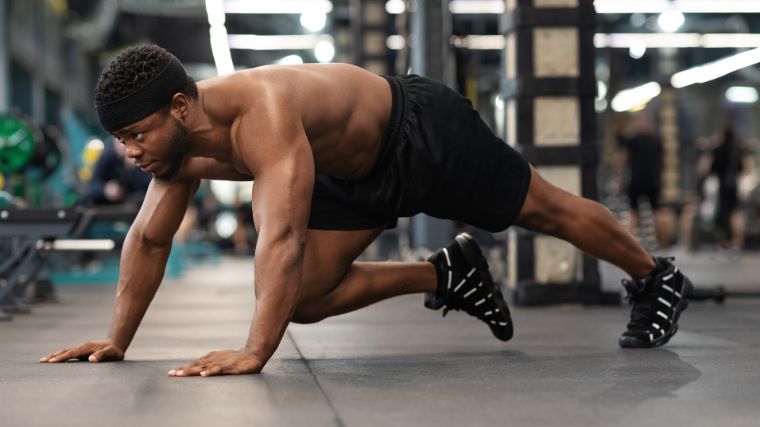
[Read More: The Gymgoer’s Guide to Whey Protein]
You don’t have to perform them for long periods to break a sweat, get your heart rate up, and tax muscles across your entire body. Average gymgoers looking for an efficient and exciting way to accomplish their goals will likely find a lot of satisfaction in this move.
CrossFitters
As a CrossFitter, you know that the name of the game is functionality across multiple modalities. Mountain climbers tick a lot of boxes. They prepare your body to crawl, resist dynamic forces and pressures, and develop speed, power, strength, and coordination.
Mountain climbers do all of this while presenting a tremendous challenge to your heart rate and your ability to push past mental barriers and keep going through a hard set. These are all important qualities in a CrossFit workout, making these a high-value addition — especially if you’re doing your CrossFit workouts at home.
Powerlifters
While powerlifters rarely do the same types of workouts as CrossFitters, mountain climbers can be exceptionally helpful for powerlifters. When longer cardio conditioning workouts are sparse on your squat, bench press, and deadlift agenda, mountain climbers are a quick and easy way to get your heart rate up as a powerlifter.
It won’t take a lot of time investment to give yourself a good cardio workout. And because it’s relatively low-impact — especially if you’re tapping your feet instead of hopping — you’ll be able to do it as a finisher with minimal demands on your overall recovery.
Common Mountain Climber Mistakes
Mountain climbers look both intimidating and deceptively simple — somehow all at the same time. Avoid these common hiccups to make sure you’re elevating your training as efficiently as possible.
Rounding Lower Back
It’s tempting to round your lower back or arch it toward the ceiling to compensate for the hard work your hips, core, and legs will be doing. But doing so will take the stability out of your core. That’s not good news if you want to increase strength in your core since you won’t be working your muscles as hard as possible.
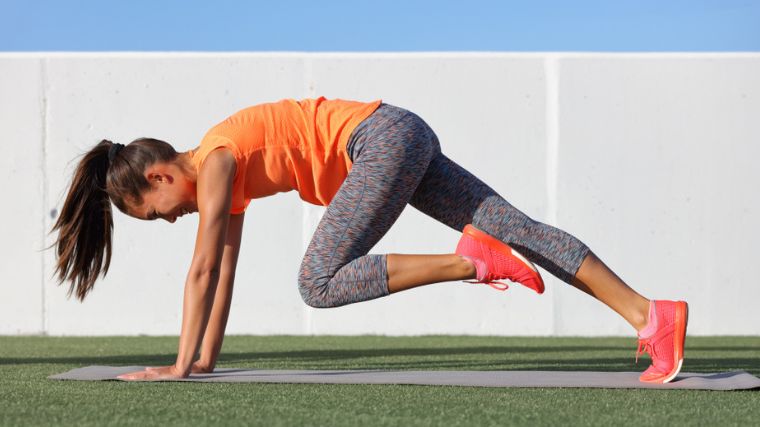
You’ll also want to avoid rounding your lower back because by insufficiently engaging your abs, you might risk putting unwanted pressure on your back. Instead, focus on pulling your knees into your chest with your stomach, not thrusting them forward with the weight of your back behind them.
Lateral Hip Shifts
Some shifting back and forth is natural during mountain climbers. But you’ll want to make sure your hips aren’t swinging along with your movements. This can take the emphasis off your core — making the exercise less effective. More importantly, these shifts can potentially expose you to a higher risk of lower back strain.
You want to maintain an emphasis on your core. To do this, keep your hips as stable as possible. Encourage the movement of your legs to come from your core stability, rather than simply kicking your knees up — this should help maximize core engagement and minimize unnecessary hip shifting.
Sagging Chest
If your chest sinks during your mountain climbers, it may feel like you’re taking a load off your shoulders. But this slip in form can set you up for weakening your shoulders and even potentially increasing your risk of getting hurt.
[Read More: 5 Bench Press Programs to Build a Bigger, Stronger Chest]
To help you manage injury risk, keep your shoulders actively engaged throughout your sets. This means keeping them back and down, without letting them wing upward as your chest sinks toward the ground. Keep your core engaged to help with this, too.
Get Climbing
You don’t need to actually climb anything to get a whole lot stronger. Without ever leaving the ground, mountain climbers can help build your upper body stability and lower body strength while increasing core stability under dynamic pressure.
Especially if you step lively, this exercise can also pack a cardiovascular wallop. From beginners to advanced lifters, you can bring the mountain to you bring your fitness to new heights.
FAQs
Just because they’re a classic in the gym doesn’t mean you can learn everything you need to know about them by osmosis. Let’s clear up a few final questions here:
How many mountain climbers should you be able to do?
Everyone’s fitness levels and bodies are different, so there will be an incredible amount of customization here. However, for beginners, you might want to set a goal of performing 10 total reps, then gradually upping your game to be able to do 10 per side. Intermediate athletes can try to accomplish 30 total, then eventually 40 total (20 per side).
Advanced athletes may find themselves going upwards of that, aiming to do as many as possible in a given time frame (a minute or even more) to beat the clock and their previous best score.
Do mountain climbers burn belly fat?
Spot fat reduction is a myth. No exercise is going to automatically “burn” fat off a specifc part of your body — that’s just not how it works. But mountain climbers can certainly be part of a well-designed exercise program and nutritional strategy if one of your goals is to lose body weight.
Balance, sustainability, and consistency will be the key to any body compositional changes. If you enjoy mountain climbers, they’re more likely to become part of a sustainable program aimed at potential weight loss.
Should you do mountain climbers fast or slow?
Mountain climbers are great whether you perform them fast, slow, somewhere in the middle, or alternate between different sets. If you’re aiming to put extra emphasis on your core strength, perform them under slow control to tax those muscles. When you’re after a more cardiovascular boost to up your heart rate, opt to move more quickly.
Featured Image: Roman Samborskyi / Shutterstock